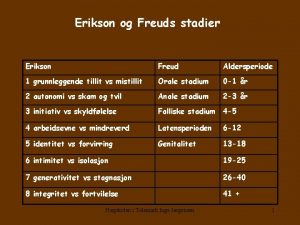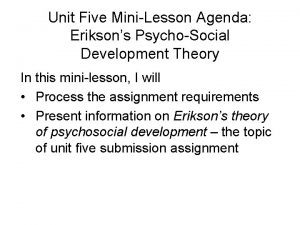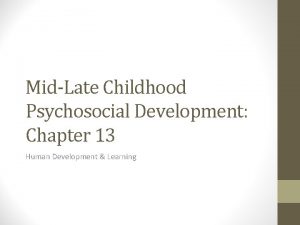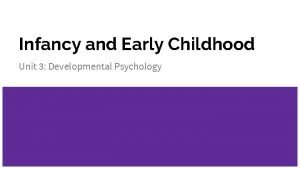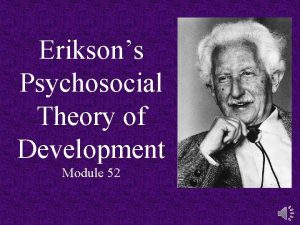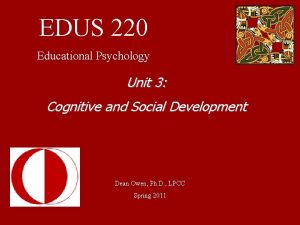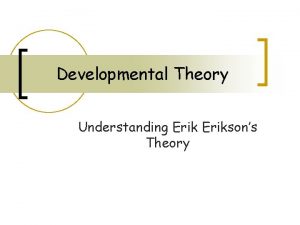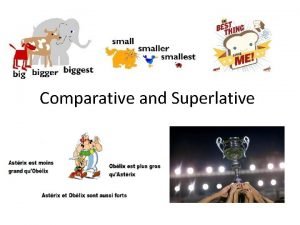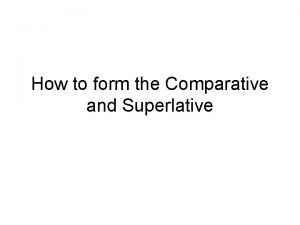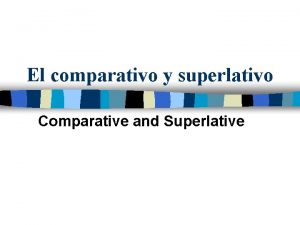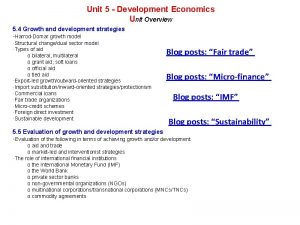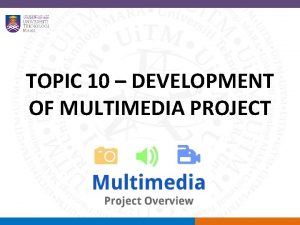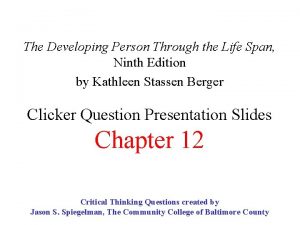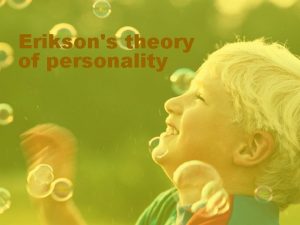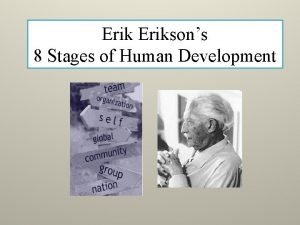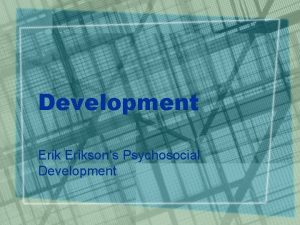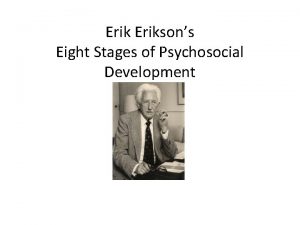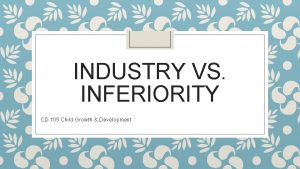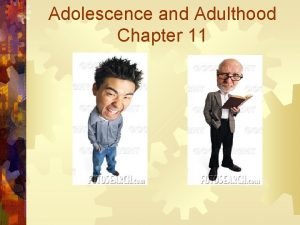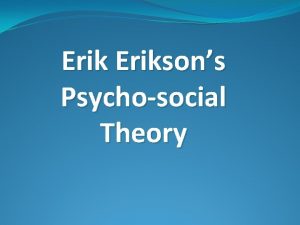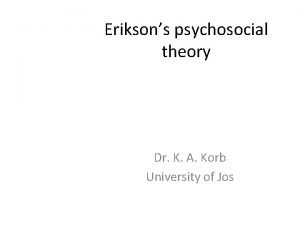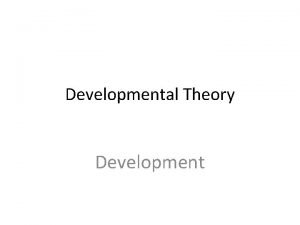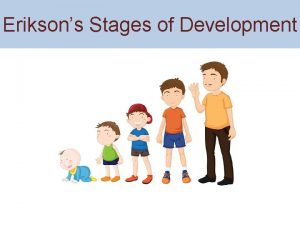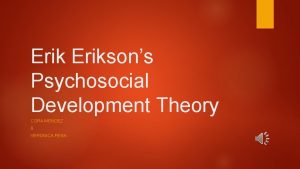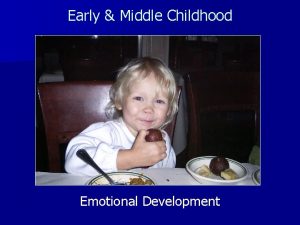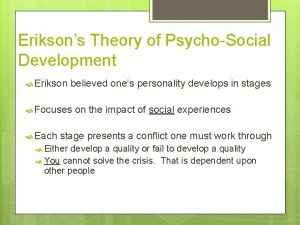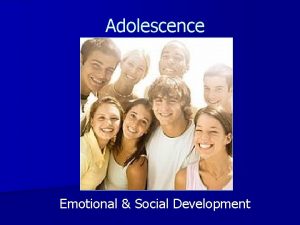Eriksons Theory Industry vs Inferiority Industry Inferiority Developing


























- Slides: 26

Erikson’s Theory: Industry vs. Inferiority Industry Inferiority § Developing a sense of competence at useful skills and tasks § School provides many opportunities § Pessimism and lack of confidence in own ability to do things well § Negative responses from family, teachers, and peers can contribute to negative feelings

Changes in Self-Concept During Middle Childhood In middle childhood children look to more people beyond the family for information about themselves as they enter a wider range of settings in the school and in the community Self concept varies from culture to culture. For example in Asian parents stress harmonious interdependence where as Western parents stress independence Social comparisons-making judgements of one’s own appearance, abilities, and behavior in relation to others

Hierarchical Structure of Self-Esteem in Middle Childhood

Influences on Self-Esteem Stop and think! What social influences might lead self-esteem to be high for some children and low for others?

Influences on Self-Esteem Refer to your textbook : How does the following influence self-esteem § Culture (page 261) § Child rearing practices (page 262) § Achievement related attributions (page 263)

Role of Parenting in Self-Esteem • Authoritative style is best • Risks of controlling parenting: low self-esteem, aggression, and antisocial behavior • Risks of indulgent parenting: unrealistically high self-esteem, lashing out at challenges to overblown self-images • Encourage worthwhile goal-setting to boost self-esteem

Emotional Development Self Conscious emotions § In middle childhood, the self conscious emotions of pride and guilt become clearly governed by personal responsibility § Pride motivates children to take on further challenges whereas guilt prompts them to make amends and to strive for self-improvement

Emotional Development Emotional Understanding § School age children are more likely to explain emotion by referring to internal states such as happy or sad thoughts. § Between the ages of 6 and 12, children become more aware of circumstances likely to spark mixed emotions § Appreciating mixed emotions helps children realize that people’s expressions may not reflect their true feelings

Emotional Development Emotional Self-Regulation § During middle childhood, there is rapid gains in emotional self regulation § Children must learn to manage negative emotion that threatens their self-esteem

Changes in Moral Understanding • Flexible moral rules: • lying not always bad/truthfulness not always good • considers prosocial and antisocial intentions • Clarifies link between moral imperatives and social conventions: • considers people’s intentions and the contexts of their actions • Cultural similarities/differences What are examples of some of the cultural similarities. How about the differences? Refer to the top of page 266

Coping Strategies Problem-Centered Coping Emotion-Centered Coping • Appraise situation as changeable • Identify difficulty • Decide what to do • Use when problem-centered coping does not work • Internal, private, and aimed at controlling distress when little can be done about outcome

Friendship in Middle Childhood § Personal qualities, trust become important § More selective in choosing friends: • tends to select friends similar to self § Friendships fairly stable, can last several years § Type of friends affects development: • aggressive friends often magnify antisocial acts

Bullies and Victims Bullies Victims • Most are boys • Physically, verbally, relationally aggressive • Socially prominent, powerful • Passive when active behavior expected • Lack defenders • Inhibited temperament • Physically frail • Overly protective, controlling parents

Helping Rejected Children • Coach positive social skills. • Promote perspective taking and social problem solving. • Alter peers’ negative opinions. • Intervene in negative parenting practices.

Gender Typing in Middle Childhood § Research in many countries show that stereotyping of personality traits increases steadily in middle childhood § There are sex differences in behavior as well as from adult treatment. For example, parents behave in a more mastery oriented fashion with sons, setting higher standards, explaining concepts and pointing out pursuits. § Parents less often encourage girls to make their own decisions § In line with adult stereotypes, school age children figure out which academic subjects and skill areas are “masculine” and which are “feminine”. They often regard reading, spelling, art, and music as more for girls and mathematics, athletics and mechanical skills for boys.

Family influences Parent child relationships § In middle school, the amount of time children spend with parents declines dramatically. § During this time, children become independent and parents deal with new issues such as whether their children's friends are good influences § Child rearing becomes easier for those parents who established an authoritative style during the early years § As children demonstrate that they can manage daily activities and responsibilities, effective parents engage in coregulation, a form of supervision in which parents exercise general oversight while letting children take charge of moment by moment decision making.

Family Influences Siblings § Sibling rivalry tend to increase in middle childhood § School age siblings rely on each other for companionship and support § Parental encouragement of warm, considerate sibling ties is vital

Only Children • Only children are higher in self esteem, do better in school, and attain higher levels of education • Only children have closer relationships with parents, who may exert more pressure for mastery and accomplishments • Only children tend to be less well accepted in the peer group because they have not had the opportunities to learn effective conflict resolution strategies through sibling interactions.

International Divorce Rates

Consequences of Parental Divorce Immediate Long-Term • Drop in income • Parental stress, disorganized home life • Child reactions vary with age, sex, temperament • Improved adjustment after two years • Multiple divorces associated with greater adjustment difficulties • Father’s involvement and effective coparenting improve adjustment

Helping Families Through Divorce • Shield children from conflict. • Provide continuity in daily life. • Explain the divorce. • Emphasize permanence of situation. • Sympathize with children’s feelings. • Use authoritative parenting. • Promote relationship with both parents.

Blended Families Mother–Stepfather Father–Stepmother • Most common • Boys tend to adjust quickly • Girls often adapt less favorably • Older children and adolescents of both sexes display more adjustment problems • Often leads to reduced father –child contact • Children in father custody often react negatively • Girls and stepmothers slow to get along at first, gradually adapt favorably

Maternal Employment and Child Development §Benefits: § higher self-esteem § positive family and peer relations § fewer gender stereotypes § better grades § more father involvement § Drawbacks: § heavy employment demands associated with ineffective parenting

Fears and Anxieties in Middle Childhood • Common fears include • • • poor academic performance peer rejection personal harm threats to parents’ health frightening media events • School phobia: • 5– 7 years: maternal separation • 11– 13: particular aspects of school • Harsh living conditions promote severe anxieties

Ethnic and Political Violence • Chronically dangerous environments: • • loss of sense of safety desensitization to violence impaired moral reasoning pessimistic view of future • Parents, communities, schools must provide reassurance, security, intervention: • preserve physical, psychological, educational well-being

Child Sexual Abuse • Characteristics of victims More often girls Most cases reported in middle childhood • Characteristics of abusers Usually male Usually a parent or known by parent Internet and mobile phones used to commit abuse • Consequences Emotional, physical, and behavioral reactions May persist for years • Prevention and treatment Prevention: education Treatment: long-term therapy
 Example of industry vs inferiority
Example of industry vs inferiority Ego strength erikson
Ego strength erikson Freud stadier
Freud stadier Maladaptation of trust vs mistrust
Maladaptation of trust vs mistrust Repeated systematic efforts to inflict harm
Repeated systematic efforts to inflict harm Phallic fixation
Phallic fixation Trust vs mistrust example
Trust vs mistrust example Industry vs inferiority erikson
Industry vs inferiority erikson Erikson’s stages of psychosocial development
Erikson’s stages of psychosocial development Autonomy versus shame
Autonomy versus shame Industry vs inferiority
Industry vs inferiority Frontal theory
Frontal theory Adjective degree
Adjective degree Comparative of inferiority short adjectives
Comparative of inferiority short adjectives Comparative form
Comparative form Psychodynamic theory ap psychology
Psychodynamic theory ap psychology Inferiority synonym
Inferiority synonym Comparative and superlative calm
Comparative and superlative calm Inferiority complex
Inferiority complex Superlative de older
Superlative de older Pretest: developing an academic and career plan
Pretest: developing an academic and career plan Application of harrod-domar model in developing countries
Application of harrod-domar model in developing countries Comparative education in developed countries
Comparative education in developed countries Section quiz 4-3 developing federalism
Section quiz 4-3 developing federalism List and explain the stage of multimedia authoring
List and explain the stage of multimedia authoring Identify the rea
Identify the rea The developing person through the life span 9th edition
The developing person through the life span 9th edition


